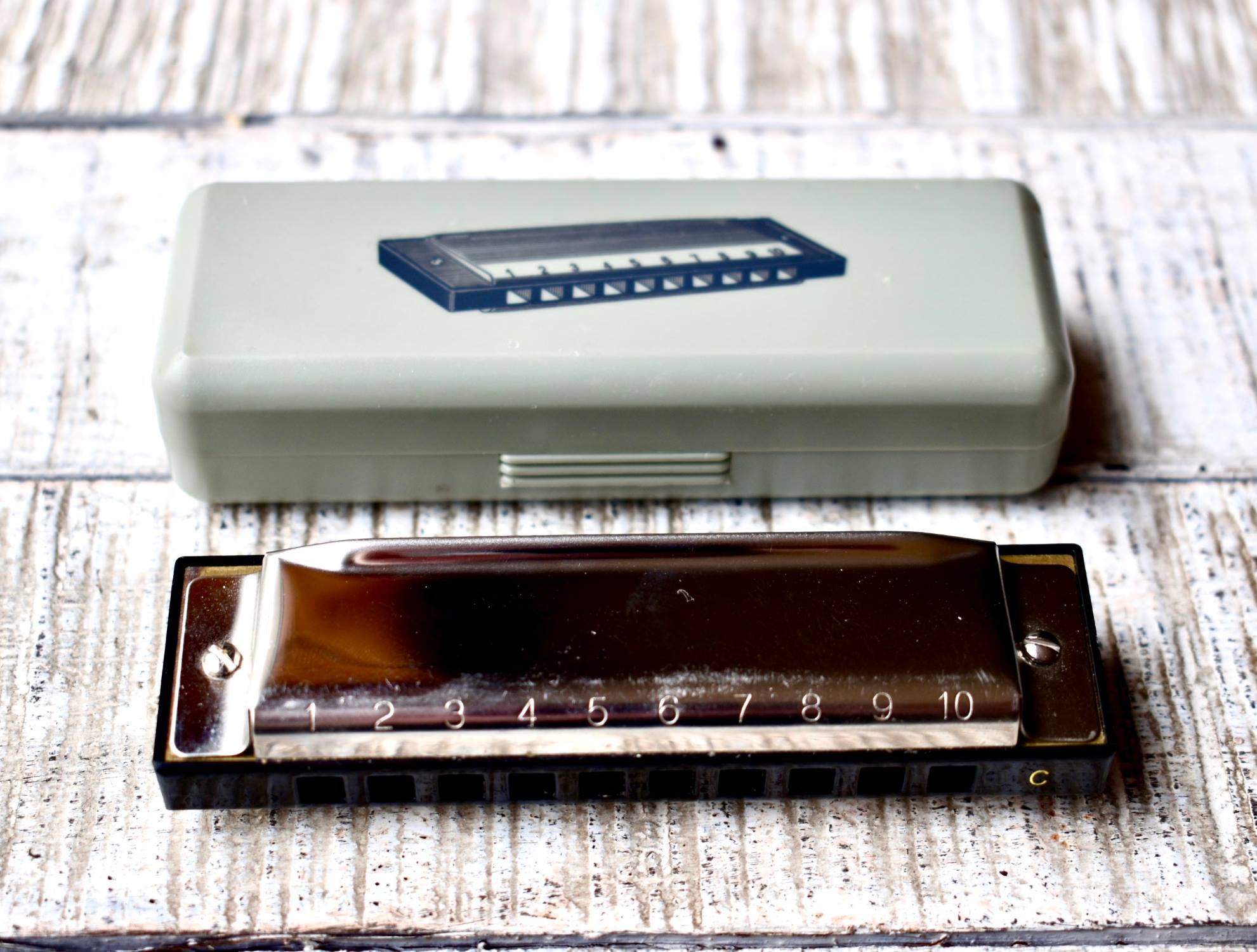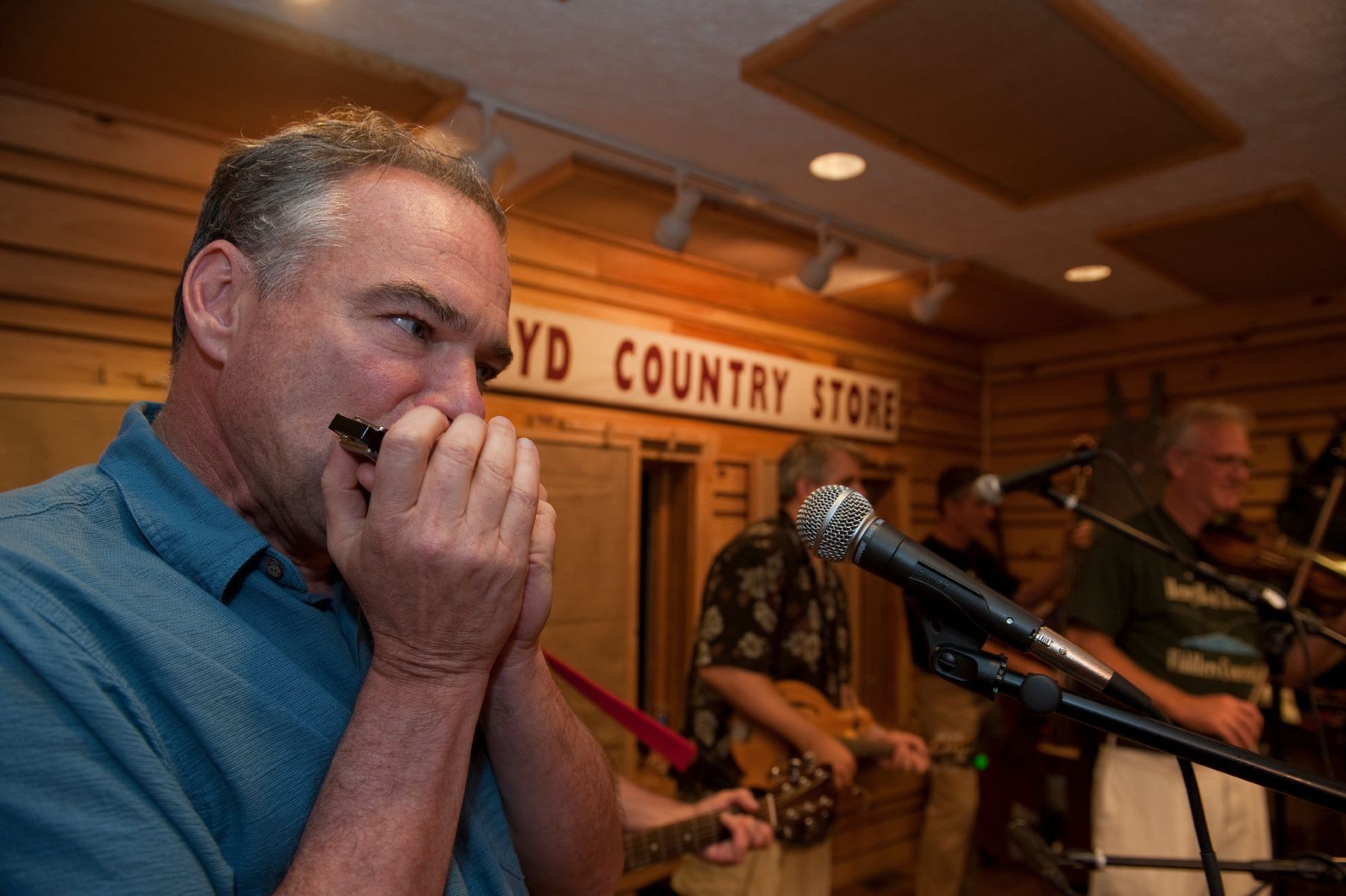Home>Instruments>Harmonica>How To Tongue Block Harmonica


Harmonica
How To Tongue Block Harmonica
Published: February 3, 2024
Learn how to tongue block on harmonica and improve your playing technique. Discover tips and techniques for mastering the harmonica
(Many of the links in this article redirect to a specific reviewed product. Your purchase of these products through affiliate links helps to generate commission for AudioLover.com, at no extra cost. Learn more)
Table of Contents
Introduction
The harmonica is a versatile and captivating musical instrument that has captured the hearts of music enthusiasts around the world. Whether you’re a seasoned musician or just starting your musical journey, the harmonica offers a unique sound that can add charm and depth to any genre of music.
One technique that can greatly enhance your harmonica playing skills is tongue blocking. Tongue blocking involves using your tongue to block certain holes on the harmonica while playing, allowing you to create a variety of musical effects and gain more control over your sound. In this article, we will explore the art of tongue blocking, its benefits, and how you can get started with this technique.
Mastering tongue blocking can open up a whole new world of possibilities on the harmonica. It allows you to create complex chord patterns, produce distinct note bending techniques, and add unique percussive elements to your playing. It’s a technique that separates harmonica players who are merely good from those who are truly exceptional.
Whether you’re interested in blues, folk, rock, or jazz, tongue blocking can help you achieve a richer and more expressive sound. By using your tongue as a barrier, you can isolate individual notes, create rich chords, and produce beautiful vibrato and trills.
In the following sections, we will delve deeper into the benefits of tongue blocking, discuss different tongue placement techniques, explore common and advanced tongue blocking techniques, and provide tips for troubleshooting common issues. So, grab your harmonica and get ready to take your playing to the next level with tongue blocking!
What is Tongue Blocking?
Tongue blocking is a playing technique used by harmonica players to manipulate the sound and produce a wide range of tonal effects. Unlike other playing techniques such as lip pursing or puckering, tongue blocking involves using the tongue to block certain holes of the harmonica while playing.
With tongue blocking, the player positions their tongue across multiple holes to create a barrier, effectively blocking some of the holes while leaving others open. This technique allows for more precise control over individual notes, as well as the ability to create chords and produce unique sounds by combining played and blocked holes.
By using tongue blocking, harmonica players can achieve a variety of musical effects, such as bends, splits, trills, and vibrato. Tongue blocking also facilitates playing octaves and can add percussive elements to the sound, enhancing the rhythmic qualities of the music.
One of the main advantages of tongue blocking is the ability to produce a full and clear sound while maintaining control over individual notes. By blocking some holes and directing the airstream at specific reeds, players can create a richer and more resonant tone.
Tongue blocking is commonly associated with blues and folk music, where it is used to create the distinctive sound and emotive qualities of the harmonica. The technique provides a way to mimic the sound of a crying or moaning voice, adding a unique and expressive element to the music.
Overall, tongue blocking is a versatile technique that allows harmonica players to expand their musical repertoire and explore new tonal possibilities. It requires practice and patience to master, but the rewards are well worth the effort. So, if you’re ready to dive into the world of tongue blocking, let’s move on to the next section where we will discuss the benefits of incorporating this technique into your harmonica playing.
Benefits of Tongue Blocking
Tongue blocking is a fundamental technique in harmonica playing that offers a multitude of benefits for players of all skill levels. Whether you’re a beginner or an experienced musician, incorporating tongue blocking into your repertoire can greatly enhance your harmonica playing. Here are some of the key benefits of tongue blocking:
- Greater control and precision: Tongue blocking allows you to have precise control over individual notes by blocking specific holes on the harmonica. This level of control enables you to produce clearer and more distinct notes, enhancing your overall playing technique.
- Richer sound and tonal effects: By using tongue blocking, you can create a wider range of tonal effects on the harmonica. Bends, vibrato, trills, and chordal playing are just a few examples of the expressive techniques that can be achieved through tongue blocking. These techniques add depth and richness to your sound, allowing you to create captivating melodies.
- Ability to play chords: One of the major advantages of tongue blocking is the ability to play multiple notes simultaneously, creating harmonies and chords. This opens up a whole new dimension in your harmonica playing, enabling you to mimic the sounds of accompanying instruments and create a fuller, more complex musical arrangement.
- Enhanced rhythmic possibilities: Tongue blocking can also add percussive elements to your playing. By tapping or slapping your tongue against the harmonica while blocking certain holes, you can create rhythmic accents and syncopated patterns. This rhythmic versatility allows you to explore various genres and styles of music, from blues to folk to jazz.
- Expressive and emotive playing: Tongue blocking is often associated with blues music because of its ability to mimic the human voice. By using this technique, you can create a crying or moaning sound on the harmonica, evoking powerful emotions in your playing. This adds a unique and soulful element to your music, captivating listeners and making your performances truly memorable.
Overall, tongue blocking offers a wide range of benefits that can elevate your harmonica playing to new heights. Whether you’re aiming to improve your technique, explore new tonal possibilities, or add an expressive touch to your music, incorporating tongue blocking into your playing style is a worthwhile pursuit. In the next section, we will delve into the details of getting started with tongue blocking.
Getting Started with Tongue Blocking
If you’re ready to dive into the world of tongue blocking and take your harmonica playing to the next level, here are some essential tips to get you started:
- Positioning the harmonica: Hold the harmonica with both hands, using your left hand to support the lower end and your right hand to cover the upper end. Make sure the numbers printed on the harmonica are facing you, indicating the blow notes.
- Tongue placement: Place your tongue on the harmonica, lightly touching the holes that you want to block. Start by blocking just a single hole and practice playing a single note while keeping the other holes unobstructed. Gradually progress to blocking multiple holes and playing chords as you gain more control and confidence.
- Experiment with tongue position: Try different tongue positions to explore various tonal effects. Placing your tongue towards the back of the harmonica will produce a darker and mellow sound, while positioning it towards the front will create a brighter and crisper tone. Take your time to find the sweet spot that works best for you.
- Air control: Focus on controlling your airflow while tongue blocking. Use your diaphragm to support your breath and maintain a consistent pressure. Experiment with the strength and speed of your breath to create different dynamics and effects.
- Start with simple exercises: Begin by practicing single notes and scales using tongue blocking. This will help you develop precision and clarity in your playing. Gradually progress to playing melodies, bending notes, and exploring more advanced techniques as you become comfortable and proficient with tongue blocking.
- Patience and practice: Mastering tongue blocking takes time and dedication. Practice regularly, starting with short sessions and gradually increasing your practice time. Be patient with yourself and allow yourself to make mistakes along the way. With persistence and consistent practice, you will see improvement and feel more confident in your tongue blocking abilities.
Remember, getting started with tongue blocking is about experimentation, finding your own style, and developing your own unique sound. Each harmonica player approaches tongue blocking differently, so don’t be afraid to explore and find what works best for you. In the next section, we will dive deeper into various tongue placement techniques to further enhance your tongue blocking skills.
Tongue Placement Techniques
When it comes to tongue blocking, the placement of your tongue on the harmonica is crucial for achieving different tonal effects and executing various techniques. Here are some common tongue placement techniques to help you enhance your tongue blocking skills:
- Single-hole block: Start by placing your tongue on a single hole, completely blocking it while leaving surrounding holes open. This technique allows you to play a single note with precision and control. Practice playing different notes using this technique to develop accuracy and strengthen your coordination.
- Multiple-hole block: As you progress, experiment with blocking multiple holes simultaneously. This technique enables you to play chords and produce richer, fuller sounds. Place your tongue across two or more adjacent holes, ensuring that you are lightly touching the holes to block them. Practice playing different combinations of blocked and open holes to create chord progressions and explore new musical possibilities.
- Blocked-hole percussive effects: Besides playing notes and chords, tongue blocking can also be used to produce percussive effects. Experiment with tapping or slapping your tongue against the holes while gently blocking them to create rhythmic accents and percussive sounds. This technique adds texture and groove to your playing, enhancing the overall musicality of your harmonica performance.
- Partial tongue block: For more nuanced control over individual notes, you can use a partial tongue block technique. Instead of completely blocking a hole, position your tongue to lightly touch the hole, allowing some airflow to escape. This technique enables you to create subtle bends, vibrato, and expressive nuances in your playing, offering a wider range of tonal possibilities.
- Tongue movement: While playing, don’t be afraid to experiment with different tongue movements. You can move your tongue slightly forward or backward, or even roll it to the side, to produce variations in sound and tone. These small adjustments can greatly impact the overall character of your playing and add a personal touch to your harmonica performance.
Remember, each player’s tongue placement techniques may vary slightly, so it’s essential to find what feels comfortable and produces the desired sound for you. It’s all about experimentation and finding your own unique style. As you continue to practice and develop your tongue blocking skills, you’ll discover new ways to manipulate the harmonica and unlock a world of musical possibilities. In the next section, we will explore common tongue blocking techniques that you can incorporate into your harmonica playing.
Developing Tongue Blocking Skills
Developing strong tongue blocking skills is essential for becoming a proficient harmonica player. With practice and dedication, you can improve your technique and master the art of tongue blocking. Here are some tips to help you develop your tongue blocking skills:
- Start with basic exercises: Begin by focusing on playing single notes using tongue blocking. Practice playing each note with clarity and precision, ensuring that you are accurately blocking and unblocking the intended holes.
- Practice scales and melodies: Once you feel comfortable with playing single notes, progress to playing scales and simple melodies using tongue blocking. This will help you develop dexterity and fluidity in your playing.
- Work on control and dynamics: Pay attention to the strength and speed of your breath while tongue blocking. Practice varying the intensity of your breath to create different dynamics and tonal effects. Explore playing softly for a whispering effect or playing forcefully for a more assertive sound.
- Experiment with bends and note variations: Tongue blocking allows you to explore bending notes and creating variations in pitch. Experiment with bending techniques by adjusting the shape and position of your tongue to achieve pitch bends and expressive notes. Practice listening closely to the pitch changes and work on achieving accurate bends.
- Learn from experienced players: Study and listen to recordings of experienced harmonica players who employ tongue blocking. Observe their techniques and try to emulate their sound and style. Online tutorials and harmonica learning resources can also provide valuable guidance for developing your tongue blocking skills.
- Record and analyze your playing: Use a recording device or smartphone to record your practice sessions. Listen back to your recordings and analyze your playing. Pay attention to areas where you may need improvement, such as note accuracy, tone quality, or control. This self-analysis can help you identify areas of focus and track your progress over time.
- Practice with different musical genres: Experiment with playing different musical genres using tongue blocking techniques. Try blues, folk, rock, jazz, or any other genre that interests you. This will help you explore the versatility of tongue blocking and its application in various musical contexts.
Consistent practice and patience are key to developing your tongue blocking skills. Set aside regular practice sessions and dedicate time to specifically focus on tongue blocking exercises. Gradually increase the difficulty of the exercises as you progress and strive to continually challenge yourself. With time and perseverance, you will see improvement in your tongue blocking abilities and witness the positive impact it has on your harmonica playing.
Common Tongue Blocking Techniques
As you delve deeper into the world of tongue blocking, you will discover a variety of techniques that can add depth and versatility to your harmonica playing. Here are some common tongue blocking techniques that you can incorporate into your repertoire:
- Octave playing: Tongue blocking allows you to play two notes at the same time, creating an octave effect. Position your tongue to block three holes, and blow or draw air to produce a powerful and harmonically-rich sound. This technique adds a fullness and richness to your playing, mimicking the sound of two harmonicas playing in harmony.
- Chordal playing: One of the most powerful and expressive techniques in tongue blocking is chordal playing. By blocking multiple holes with your tongue, you can create chords and play multiple notes simultaneously. Experiment with different combinations of blocked and unblocked holes to create a variety of chord voicings and harmonic textures.
- Tongue-slaps and tongue-stops: Take advantage of the percussive abilities of tongue blocking by incorporating tongue-slaps and tongue-stops into your playing. A tongue-slap involves forcefully tapping your tongue against the harmonica while blocking certain holes, creating a sharp and percussive sound. A tongue-stop is similar, but instead of tapping, you use your tongue to completely block the airflow, creating a brief pause in the sound.
- Note bending: Tongue blocking allows for greater control and precision when it comes to note bending. By adjusting the shape and position of your tongue, you can bend notes up or down, adding expressive and emotive qualities to your playing. Practice bending notes using tongue blocking, starting with slight bends and gradually working towards wider bends for a bluesy and soulful sound.
- Trills and vibrato: With tongue blocking, you can effortlessly create trills and vibrato. Trills involve rapidly alternating between two blocked holes, producing a fast and rhythmic effect. Vibrato is achieved by subtly moving your tongue back and forth while maintaining a blocked hole, creating a gentle oscillation in the pitch. Practice these techniques to add texture and emotion to your melodies.
These are just a few examples of the common tongue blocking techniques you can incorporate into your harmonica playing. As with any technique, it’s important to start slow, practice with precision, and gradually increase the complexity of your playing. Remember to experiment and explore, allowing your own style and creativity to shine through. The more you practice and incorporate these techniques into your playing, the more natural they will become, and the more expressive and versatile your harmonica playing will be.
Advanced Tongue Blocking Techniques
Once you have mastered the common tongue blocking techniques, you may be ready to explore more advanced techniques to further expand your repertoire and musical abilities on the harmonica. Here are a few advanced tongue blocking techniques to take your playing to the next level:
- Overblows and overdraws: Overblows and overdraws are advanced techniques that allow you to produce notes beyond the limits of the standard diatonic harmonica. With tongue blocking, you can achieve greater control and precision when executing these techniques. By manipulating the position and pressure of your tongue, you can produce these challenging yet expressive notes.
- Warbles and slurs: Warbling is a technique where you rapidly alternate between two blocked holes to create a subtle vibrato-like effect. By incorporating tongue movement and breath control, you can achieve a smooth and controlled warble. Slurring, on the other hand, involves transitioning between notes without rearticulating the tongue block. This technique adds fluidity and grace to your playing.
- Flutter tongue: Flutter tongue is a technique commonly used by woodwind players, but it can also be adopted on harmonica using tongue blocking. It involves rolling the tongue backward while maintaining a tongue block to create a fluttering or trilling sound. This technique adds a unique and expressive quality to your playing, expanding your sonic palette.
- Articulation variations: Experiment with different articulation techniques while tongue blocking to create variations in attack and articulation. For example, you can use your tongue to block the hole and unleash a burst of sound by quickly removing the block. You can also incorporate tongue slaps or stops to add percussive accents to your playing.
- Muting and half-blocking: Advanced tongue blocking techniques also include muting and half-blocking. Muting involves lightly resting your tongue on the holes without completely blocking them, producing a muted or dampened sound. Half-blocking involves partially blocking the holes with your tongue, allowing some airflow through and creating different tonal colors and effects.
These advanced tongue blocking techniques require time, patience, and practice to master. It’s important to approach them step by step, gradually building up your skills and control. Take your time to familiarize yourself with the basic versions of these techniques and work on incorporating them into your playing. As you develop proficiency, you can then experiment with different musical contexts and genres to fully unleash their creative potential.
Remember, mastering advanced tongue blocking techniques is not about rushing to achieve perfection. It’s about continually pushing your boundaries, exploring new sonic possibilities, and expressing yourself through your harmonica playing. Enjoy the journey of learning and discovering your own unique playing style, and let your creativity soar with these advanced tongue blocking techniques.
Troubleshooting Tips
While tongue blocking can greatly enhance your harmonica playing, it may also present some challenges along the way. Here are some troubleshooting tips to help you overcome common issues and improve your tongue blocking technique:
- Proper tongue placement: Pay attention to the positioning of your tongue. Ensure that you are lightly touching the holes you intend to block, without completely obstructing the airflow. Practice finding the right balance between blocking and unblocking the holes to produce clear and precise notes.
- Avoid unnecessary tension: Tension in your mouth and tongue can hinder your tongue blocking technique. Relax your muscles and focus on maintaining a loose and flexible tongue. This will allow for better control and articulation while playing.
- Breath control: Uneven or excessive airflow can lead to inconsistent sound production. Practice controlling your breath and maintaining a steady, even airflow while tongue blocking. This will ensure consistent and controlled note production.
- Start with simple exercises: If you’re struggling with certain techniques or transitions, go back to practicing basic exercises. Work on single notes, scales, and simple melodies to build a solid foundation before progressing to more complex techniques.
- Focus on accuracy and timing: Precision and timing are key to successful tongue blocking. Pay attention to the timing of your tongue movements and strive for accuracy in blocking and unblocking the holes. Practice with a metronome to improve your sense of timing and rhythm.
- Record and analyze: Record your practice sessions and listen back to identify areas for improvement. Analyze your playing for any inconsistent or unclear notes, and specifically target those areas in your practice. Recording yourself also allows you to track your progress over time.
- Seek guidance: If you’re struggling with specific aspects of tongue blocking, consider seeking guidance from experienced players or taking online lessons. They can provide valuable insights and tailored advice to help you overcome challenges and refine your technique.
- Be patient and persistent: Learning tongue blocking takes time and dedication. Embrace the process and be patient with yourself. Keep practicing regularly and persistently, even if progress feels slow at times. With consistent effort, you’ll gradually improve and overcome any difficulties you encounter.
Remember, every harmonica player faces challenges along their musical journey. The key is to approach difficulties with a positive mindset and a commitment to continuous improvement. By applying these troubleshooting tips and maintaining a regular practice routine, you’ll overcome obstacles and develop a strong foundation in tongue blocking.
Now that you’re equipped with troubleshooting tips, continue honing your tongue blocking skills and exploring new possibilities on the harmonica. In the next section, we’ll wrap up our discussion and conclude our exploration of tongue blocking.
Conclusion
Tongue blocking is a powerful technique that can greatly enhance your harmonica playing. By using your tongue to block and control the airflow, you can achieve a wide range of tonal effects, play chords, and add expressive elements to your melodies. From the basic techniques of single-hole and multiple-hole blocking to more advanced techniques like overblows and flutter tongue, tongue blocking opens up a world of possibilities for your harmonica playing.
Throughout this article, we’ve explored the benefits of tongue blocking, discussed various tongue placement techniques, and provided tips for developing your tongue blocking skills. We’ve also touched on common and advanced tongue blocking techniques, as well as troubleshooting tips to overcome challenges along the way.
It’s important to remember that mastering tongue blocking takes time, practice, and patience. Embrace the process of learning, and don’t be afraid to experiment and explore different techniques. Each player develops their own unique style and sound, so listen to experienced players, study their techniques, and adapt them to create your own musical identity.
Whether you’re interested in blues, folk, rock, or jazz, incorporating tongue blocking into your harmonica playing will add depth, expressiveness, and versatility to your music. So pick up your harmonica, start practicing the techniques we’ve discussed, and let your creativity and passion guide you on this exciting harmonica journey.
With dedication and a willingness to push your boundaries, tongue blocking can become a powerful tool in your musical arsenal. So keep honing your skills, experimenting with different techniques, and most importantly, enjoy the process of making beautiful music with your harmonica.











